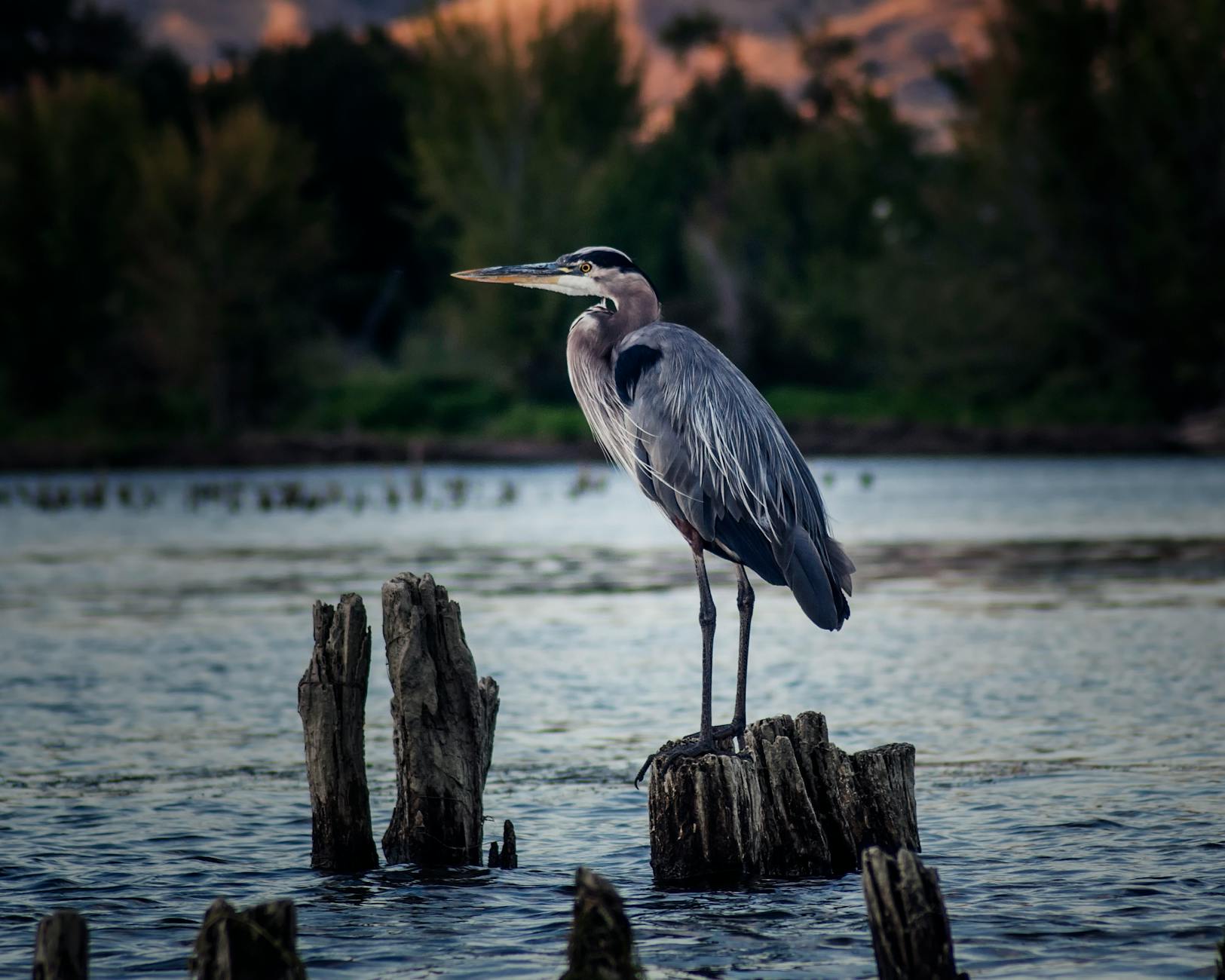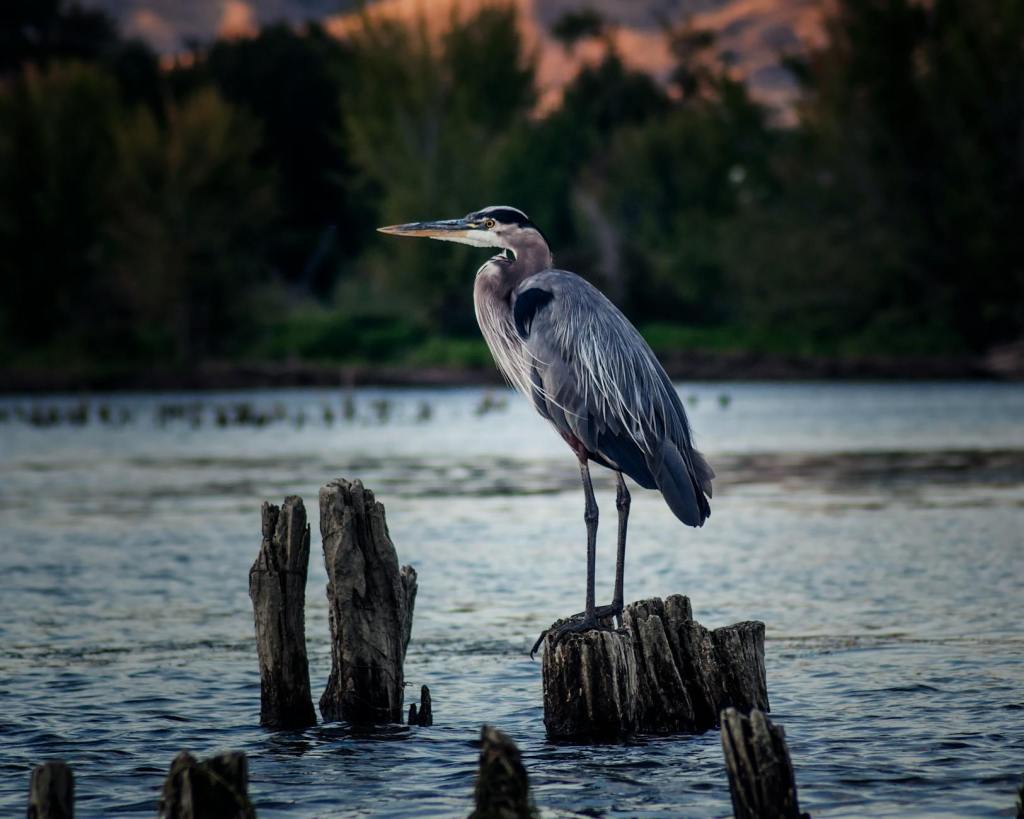
Ballona Creek Wetlands, located in Los Angeles County, California, is a vital coastal habitat teeming with diverse flora and fauna. It serves as a crucial stopover point for migratory birds along the Pacific Flyway and provides essential breeding grounds for numerous bird species. The wetlands span over 600 acres and boast a unique mix of freshwater and saltwater habitats, including marshes, tidal flats, and channels, making it a rich ecosystem supporting a variety of wildlife.
Despite being nestled amidst urban development, Ballona Creek Wetlands offers a serene escape into nature for visitors. Its accessible trails and boardwalks provide opportunities for birdwatching, nature photography, and environmental education. Managed by conservation organizations and local agencies, efforts are continually made to preserve and restore this valuable coastal wetland, ensuring its significance for both wildlife and the community.
The Blue Heron
The blue heron, a majestic avian species characterized by its long, slender neck and striking blue-gray plumage, embodies grace and tranquility in its habitat. With a wingspan often spanning over six feet, this elegant bird can be found wading in shallow waters, patiently stalking its prey with poised precision.
Its sharp, dagger-like bill and keen eyesight make it a formidable hunter, adept at snaring fish, frogs, and other aquatic creatures. Despite its imposing stature, the blue heron moves with a silent, stealthy grace, effortlessly blending into its surroundings as it navigates marshes, wetlands, and coastal regions. As a symbol of patience and wisdom across various cultures, the blue heron captivates observers with its beauty and enigmatic presence, reminding us of the delicate balance and harmony within the natural world.
Blue herons, commonly found in the Ballona Creek Wetlands in Los Angeles, inhabit a diverse range of wetland environments, including marshes, swamps, and shallow waterways. They are characterized by their tall, slender stature and long, dagger-like bills, ideal for capturing fish and other aquatic prey.
These majestic birds are often solitary hunters, patiently stalking their prey along the water’s edge before striking with lightning speed. Their behavior includes standing motionless for extended periods, waiting for the opportune moment to strike, or slowly wading through the water with deliberate steps. Blue herons are also known for their distinctive “S” shaped necks and slow, graceful flight, often seen soaring overhead or perched on branches near waterways, adding to the tranquil beauty of the wetland landscape.
The best time of year to see the blue herons at the Ballona Creek Wetlands in Los Angeles, California, is typically during the spring and summer months. During this time, blue herons are more active as they engage in breeding activities and forage for food in the wetlands. They may also be more visible during the early morning or late afternoon hours when they are actively hunting for fish, frogs, and other prey along the creek and in the marshy areas. However, blue herons can be spotted in the wetlands throughout the year, so visitors may still have opportunities to see them during other seasons, albeit with potentially varying levels of activity and visibility.
Blue herons play a significant role in the ecosystem of the Ballona Creek Wetlands and similar habitats as they are apex predators, regulating populations of small fish, frogs, and other aquatic organisms. By preying on these species, they help maintain a balanced ecosystem, preventing overpopulation of certain prey species and promoting biodiversity. Additionally, their foraging behavior and movements within the wetlands can help to redistribute nutrients and promote the health of the aquatic ecosystem. Furthermore, blue herons serve as indicators of wetland health, as their presence or absence can reflect changes in water quality, habitat availability, and overall ecosystem condition, making them valuable symbols of the wetland’s ecological integrity.
Ballona Creek Wetlands
The Ballona Creek Wetlands ecosystem, nestled along the coast of Southern California, is a vital haven for diverse flora and fauna amidst urban development. Spanning over 600 acres of marshland, mudflats, and open water, this ecologically rich area serves as a crucial habitat for numerous species, including migratory birds, fish, reptiles, and mammals. Its mosaic of habitats supports a complex web of life, with salt marshes providing nursery grounds for fish and invertebrates, while tidal channels offer shelter and feeding grounds for waterfowl and shorebirds.
Despite facing threats from habitat loss and pollution, conservation efforts strive to protect and restore this valuable ecosystem, recognizing its significance not only for biodiversity but also for flood protection, water filtration, and recreational enjoyment. The Ballona Wetlands stand as a reminder of the importance of preserving and restoring coastal ecosystems to ensure the health and resilience of both wildlife and communities in the face of environmental challenges.
Wetlands conservation is critical due to their multifaceted contributions to both ecosystems and human well-being. These habitats serve as natural filters, cleansing water by trapping pollutants and improving water quality. Moreover, wetlands act as vital buffers against floods, absorbing excess water during storms and reducing the risk of inundation in nearby communities. They also play a crucial role in climate change mitigation, sequestering carbon dioxide and helping to regulate the global climate. Additionally, wetlands support a remarkable diversity of plant and animal species, serving as breeding grounds for birds, nurseries for fish, and habitats for countless flora and fauna.
Economically, wetlands contribute to local economies through fisheries, tourism, and recreational activities, while also providing resources such as timber and medicinal plants. Culturally, these ecosystems hold spiritual significance for many communities and are repositories of traditional knowledge and practices.
Furthermore, wetlands conservation is essential for maintaining the resilience of ecosystems and the services they provide. By protecting wetlands, we safeguard water resources, support biodiversity, mitigate climate change impacts, and preserve cultural heritage, ultimately ensuring the sustainability of both natural and human systems.
The accessibility and amenities for visitors at the Ballona Creek Wetlands in Los Angeles, California, vary but generally offer opportunities for walking, biking, and wildlife observation along trails and viewing platforms. Interpretive signage enhances understanding of the ecology, while visitor centers may provide educational programs. Efforts are made to ensure accessibility with features like paved pathways and accessible parking, while restrooms and picnic areas contribute to visitor comfort. Regulations governing activities within the wetlands help protect the ecosystem, and visitors are advised to check with local authorities for the latest information on accessibility and amenities, considering any seasonal variations or special events.
Conclusion
The Ballona Creek Wetlands in Los Angeles offer a rich and diverse ecosystem where visitors can experience the wonders of nature, including the majestic blue heron. With its towering presence and graceful movements, the blue heron symbolizes the delicate balance of life within the wetlands.
As apex predators, these birds play a vital role in maintaining the health and biodiversity of the ecosystem, while also serving as indicators of its overall well-being. Whether silently stalking their prey or soaring gracefully overhead, encountering a blue heron in the Ballona Creek Wetlands is a reminder of the importance of preserving and protecting these precious natural habitats for future generations to enjoy. So, next time you visit, keep an eye out for these magnificent creatures and take a moment to appreciate their significance in this thriving wetland ecosystem.
